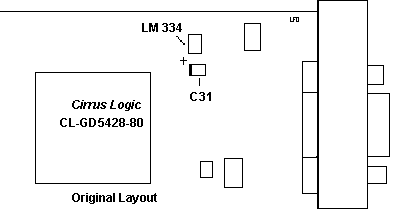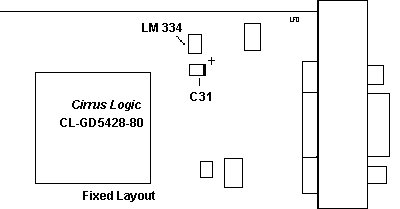|
@917B.ADF SVGA Adapter (US/EMEA)
720svga.exe PC Server 720 SVGA support diskette version 1.01 (includes CLMODE)
720svga.txt Readme for 720svga.exe
06H6915 SVGA Adapter BIOS ROM (from David Beem)
"CL-GD542X VGA BIOS Version 1.41"
Cirrus GD542x SVGA Adapters
1MB Short SVGA
Using 1MB SVGA in Model 60?
Flicker in 1MB SVGA
Flicker Fix for 1MB SVGA
Ratings for C31 Replacement
2MB Short SVGA?
ADF Sections
1MB Short SVGA FRU P/N 71G0650, P/N 06H6917, "DELIVERY BOYS"
![Front [P]](/other/img/photo.gif)
![Front (alt) [P]](/other/img/photo.gif)

J1 HDD15 video connector
U1 Cirrus CL-GD5428-80QC-A
U2 74F244D
U3 06H2194 PAL
U4 BIOS 06H6915 (REV 1.0 1994)
|
U5,6 74F373D
U7,8 NEC 424260-70 or compatible
U9 LM334 Current Source
C31 Capacitor
|
For the chipheads, the Tech Ref Annexes B-7 thru B-10 have some application
notes. Data sheet is 4.8MB, Tech Ref is 2.7MB. Everybody needs to thank Elar
Saar for guarding these files until the fullness of time.
Peter says:
Is it really a 1MB ? I have a card FRU 71G0650 with Cirrus Logic
CL-GD5428-80QC-A chipset right here on my table. Has FCC ID ANO06H3638 and I
forgot to write the Card-ID on it ... but I guess it was 917B. This thingy has
2 SMD memory chips NEC 424260-70 in the top / front corner (aligned top-down)
which are 512K x 8 bit (or 256K x 16 bit), IIRC.
The CL chipset -by the way- is a mask-programmed graphic chip with
integrated timing oscillator (no external Xtal) and integrated 80MHz RAMDAC.
Very compact design. A similar chipset is used on the Server 320/520 MCA/PCI
planar. Here they used the CL-GD5430-QC-D and 2 x Siemens HYB514171BJ-70 (256K
x 16 bit).
Using 1MB SVGA in Model 60?
Wolfgang Gehl wrote:
In fact, the Cirrus SVGA adapter is not the Texas Instruments SVGA
Adapter (=SVGA Adapter/A or IBM256C). These are two different cards..
The Cirrus card provides VESA support through BIOS, no need for a TSR
program. Use the clmode utility from 720svga.exe to adjust the vertical refresh
rate according to your LCD display.
There seems to be a resource conflict with the model 60 planar VGA which
can't be solved by system setup. In that case, unfortunately, the Cirrus SVGA
will not work in a reliable and defined state in your machine.
WBST:
Since the Cirrus Logic 5428-based 1MB SVGA Adapter/A has both a
BVE extension AND an (S)VGA (VBE) BIOS and I/O addresses etc. it comes into
conflict with any onboard VGA-based systems, unlike non-planar based
Server-class systems with BVE slot, for which it was intended. Its BIOS
probably isn't coded for this circumstance, to disable any onboard VGA during
its configuration/activation. Look to the PC Server 720's support diskettes for
related drivers etc. It has the on-planar Cirrus Logic (S)VGA 54xx-based
chipset and BIOS.
Flicker in 1MB SVGA
I (god Emperor of Microchannel) and others have noticed that the 1MB SVGA
flickers. Behold what devious minds can do.
Dr. Jim
> Technically speaking, what we are seeing is random changes in average
brightness level.

Peter:
During my first inspection of the card I came across a constant
current source, which consists out of a LM334M (U9), 22 Ohms resistor (R36),
150 Ohms (R37), a "JF" marked SMD diode (D1), a SMD tantalum 2µ2 cap (C31) and
a small pF cap (C65). Located in the top / rear corner of the card.
If you check the connections from C31 you will find that the + marked end
goes to the V+ input of U9 @ Pin 4, while the unmarked end is tied to +5VDC ...
During operation the + end of C31 is at 3.09V ... and the - end at +5 ... with
no dynamic offset of any sorts - I'd tested that with the scope.
Shouldn't that be other way round? There is a "+" marking silkscreened on
the board, so the cap is mounted correctly regarding the silkscreen -
electrically however it is reversed. And this circuit appears to me as the
voltage reference for th CL5428-internal RAMDAC. (They pull down a definite
current to give the RAMDAC a stable base voltage for the output drivers).
What happens to a capacitor if you permanently run it at reversed polarity -
even though the voltage is rather low ? (the cap is rated 20V) Given it
develops some "leakage" and causes a parasitic current to +5V - parallel to the
current flow through U9 ? That could explain the brightness changes in the
video signal.
I'm going to unsolder the C31 next to see how the card behaves without it or
if it is intended as some sort of "choke up" capacitor. And what happens if I
reverse the polarity.
Fixed 1MB SVGA

Dr. Jim
> We need more empirical data ... !
I replaced the cap on the contemplation card a few minutes ago. This card
was known to flicker, quite badly at times, and was pulled from this machine
for that reason. I used a new 3u3/16v in the same form factor off a scrap PCB
from work.
Before I swapped the card, I laid down on the floor with my handheld DMM and
confirmed your voltage readings before powering down the 500. Results; +5.15
VDC on the - terminal of the capacitor, +3.50 VDC on the + terminal.
Backweirdness confirmed. The + end is 1.65V _more negative_ than the -
terminal.
Swapped the cards. My immediate impression was that the test card produces a
much brighter and clearer screen image than the (identical) card I took out.
This may be meaningless however, since I did not retest this card in the 500
before I changed the cap.
I have not noticed any flicker so far. I will run it for a while and try to
observe it as much as I can. This machine is my APRS server and runs 24/7, so
it should be a good test. Type 4 'Y' at 180 MHz.
David Beem provides another data point:
> Agreed. Absolutely replace the cap.
Done. 47uF, 25v. Testing now.
Fixed! I say a dramatic fix in that. I can reproduce the flickering at will
by putting in the unpatched card; It goes away with the patched version, even
for a lengthy time span. Who would have knew?
To see how this circuit is implemented on the various CL-GD542x MCA adapters
go HERE.
Ratings for C31 Replacement
I had a tag-team of David Beem and Dr. Jim working this
out.
> Point is, within reason the size doesn't matter (just here).
Electrolytics are pretty sloppy, probably close to +/- 10% on average. I think
Tantalums are generally tighter, and that's what this appears to be.
>> Capacitance range 2.2 uF to 4.7 uF, voltage of at least 20 V? Or
would 16 to 25 work?
Clone designs were using close to a 3.3uF cap. For voltages 16v is
sufficient & a commonly produced capacitor. I would stay within the range
of 2.2 to 5 uF. It is remotely possible that a cap that is too large may draw
excessive surge current on power up and let some of that delicate silicon smoke
loose inside the chip.
2MB Short SVGA?
Without the help of Jolt, I asked about pumping up the 1MB SVGA:

Pin 141 is right above the trace that goes to R27.
>Please point out the second pair of solder pads for additional memory on
the short 1MB.
Peter writes:
As far as I have traced the connections on the short Cirrus as
well as on the Reply Mod. 80 board you could solder another pair of 424260 (or
4C1627 from Micron) 1:1 over the existing chips - minus the pins 14 on the new
ones. These are the RAS pins, which have to be connected via a 22 Ohms resistor
to pin 141 on the CL5428 chip. It is marked OE* in the datasheet - but a
footnote says it is RAS1 on 5426/28/29 chips for the 2MB RAM
configurations.
AdapterId 917b SVGA Adapter
ROM Address
This is the address range for the video
adapter, it cannot be changed
<"C0000h-C7FFFh">
|